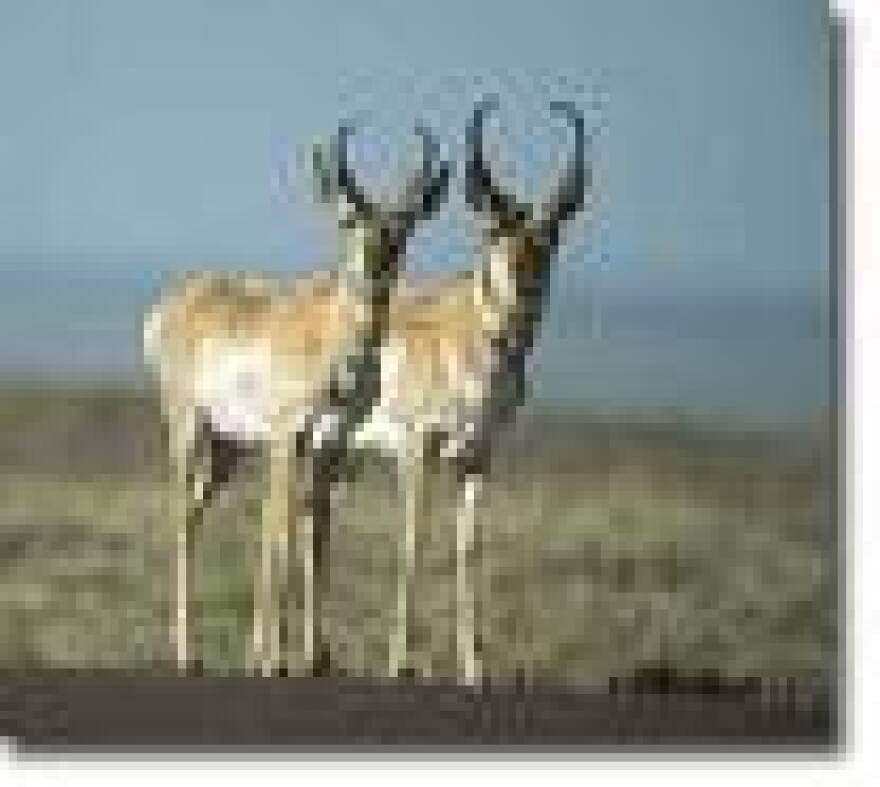By Laurel Morales
http://stream.publicbroadcasting.net/production/mp3/knau/local-knau-604398.mp3
Flagstaff, AZ – Deer, elk and antelope footprints surround a popular water hole northeast of Flagstaff. Carl Lutch, a wildlife manager for the Arizona Game and Fish Department, says that's typical especially this time of year.
AMBY: walking around catchment
Part of his job is to check on man made water holes or "catchments," as they're called, like this one.
LUTCH: They can drink it dry I've had them drink it dry in two weeks when I think it can go a month.
It looks like a small dirty swimming pool with a flat metal roof lying on the ground above it. The roof catches rainwater and funnels it into the pool. But there's no rain now so to make up for it Lutch and other wildlife managers are hauling water to these catchments so the animals won't go thirsty. There are 15-hundred catchments throughout the state.
SFX: water pouring
Lutch turns the crank on the 500-gallon water tank that he's hauled to this remote area.
AMBY: Truck
Back in the truck Lutch gives a botany lesson.
LUTCH: There's a lot of this apache plume
He points to various plants -- some native many not. He says green nutritious vegetation is lacking. (fade out truck amby) Biologists agree you can haul all the water you want but no animal can survive on water alone. ASU biologist Dave Brown says that's a problem statewide.
BROWN: Drought's not just a function of lack of water it's lack of forage. If you don't get any green plant growth, then you don't get any food for these animals and that causes them to literally starve to death.
During the current drought that's lasted about 12 years Brown studied a herd of antelope in New Mexico. He says in one year 75 percent of them died due to dry conditions. He says they've seen similar numbers for antelope in Arizona. Game and Fish biologist Randy Babb says the same is true for quail and even javelina which are typically pretty hearty animals.
BABB: It's always alarming when you see animals that are generalists that have broad habitat tolerances and dietary preferences. When their numbers decline that's usually a sign that things are pretty bad. It's a really severe it's a really dire situation for our wildlife and our wildlife habitats right now.
Babb says rivers and lakes that have been flowing for years are drying up.
He says most native Arizona wildlife is used to dry conditions and these species have survived droughts in the past. But this drought is especially severe. And he's concerned the natural drying phenomenon is working together with man-induced climate change.
BABB: There's a climatic shift natural climatic shift and there's this man induced global warming and that makes the whole situation more dicey. It seems to be the man caused portion seems to be aggravating and accelerating the natural phenomenon that we're experiencing.
State climatologist Nancy Selover says it's too early to say whether this drought is a historical event with an end date or if it's being exacerbated by climate change.
SELOVER: We need to recognize being in the desert drought is a very normal condition and it's difficult for us to sit by and watch.
Brian Wakeling says there is something we can do. Wakeling is the big game coordinator for Arizona Game and Fish. He says there are several complicating factors that are occurring at the same time. One major complication is the rapid development in northern Arizona.
WAKELING: What we routinely see especially in a drought situation is that often our urban developments occur within places that have been historically wetter areas. The parts of the country that are most aesthetically pleasing to people and the places where they want to put their houses often are the places that are the most critical habitats for wildlife.
Places like Prescott Valley and Flagstaff. That's where there's green vegetation and water. Wakeling says there's even a new development called Pronghorn Ranch in Prescott Valley that used to be home to 10 percent of Arizona's pronghorn antelope population.
WAKELING: As we keep developing I mean it's not uncommon it's still real dependable you should see pronghorn out there but you can see all the new houses going in around there.
Wakeling says this is one of the reasons black bears, javelina, deer and other animals are looking for food in town. Their usual food and water sources have been paved over or have dried up.
For Arizona Public Radio I'm Laurel Morales.


